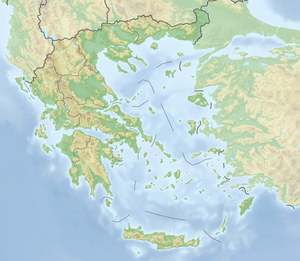Andikythira
| Andikythira (Αντικύθηρα) | ||
|---|---|---|
| Potamos, the island port | ||
| Waters | Ionian sea | |
| Archipelago | Ionian islands | |
| Geographical location | 35 ° 52 ' N , 23 ° 18' E | |
|
|
||
| length | 10.5 km | |
| width | 3.5 km | |
| surface | 19.776 km² | |
| Highest elevation | 378 m | |
| Residents | 68 (2011) | |
| main place | Potamos | |
Andikythira ( pronunciation : [ andiˈkʲiθira ], Greek Αντικύθηρα ( n. Pl. ), According to ancient Greek transcription Antikythēra ) is a small Greek island between Kythira and Crete . It came to Greece with the rest of the Ionian Islands in 1864 and until 2010 formed an independent rural community in the Attic prefecture of Piraeus . In 2011 it was merged with the neighboring island of Kythira to form the municipality of Kythira . The total area is 20 square kilometers. Only 68 permanent residents live on the island, but in the summer months the number of residents increases to several hundred.
Tourism is an essential economic factor today. Most of the island's visitors are accommodated in holiday homes and private accommodation. In addition to the ancient ruins, some chapels, windmills and a water mill in Potamos are of particular tourist interest. At the southern tip of the island there is a lighthouse from 1926. On August 17th, the residents celebrate the feast of their patron, Saint Myron of Kyzikos . Up to a thousand people come to the island for this festival.
An observation station explores the island's rich bird life.
history
The earliest documented settlement on the island dates back to the end of the Neolithic . The finds have been more frequent since the Early Bronze Age (EB II). A settlement in the early Minoan period has also been documented (FM III), however, Middle Minoan finds (MM III) are much more common. Finds from the late Minoan period (LM) point to a connection to Chania in western Crete .
In ancient Greek sources the island is called Aigila ( Αἴγιλα ) or Aigilia ( Αἰγιλία ). The oldest finds date from the time of 3500 BC. A sanctuary to Apollo was found in the ancient town of Aigila. In Hellenistic times, the island was a base for Cilician pirates . The island gained greater fame in 1900 through an ancient shipwreck that was found off the coast. Among the recovered artifacts were a sensational gear drive, known as the Antikythera Mechanism , and the Antikythera Youth , a life-size bronze figure.
The ruling republic of Venice in the Middle Ages fortified the island named Cerigotto ( "Kytherächen" , after Cerigo = Kythira) in 1207, but the relatively remote place was still the target of pirate attacks. The names Lii ( Greek Λιοί ) and Sigilio ( Greek Σιγιλιό ) are documented from the 17th century . Today's residents are largely descendants of settlers who came to the island from Crete in 1792. With the end of Venice, the island became part of the Republic of the Ionian Islands and with this in 1864 it became part of the Greek state.
The island is being explored systematically and extensively as part of the joint Antikythera project of Trent University (Canada), University College London and the Archaeological Service of the Greek Ministry of Culture. Underwater archaeologists also regularly examine the sea floor around the shipwreck. More artifacts were found in 2017.
Web links
- Antikythera Survey Project , www.ucl.ac.uk (English, Greek)
Individual evidence
- ^ Charles Arnold (ed.): The islands of the Mediterranean . A unique and complete overview. 2nd Edition. marebuchverlag, Hamburg 2008, ISBN 3-86648-096-2 .
- ↑ Results of the 2011 census at the National Statistical Service of Greece (ΕΛ.ΣΤΑΤ) ( Memento from June 27, 2015 in the Internet Archive ) (Excel document, 2.6 MB)
- ^ Antikythera Survey Project. Prehistoric Pottery. www.tuarc.trentu.ca, accessed on July 3, 2016 (English).
- ↑ Kythira.info accessed on February 26, 2020
- ^ Antikythera Survey Project. Introduction. www.tuarc.trentu.ca, accessed on July 3, 2016 (English).
- ↑ 2017 Return to Antikythera Expedition youtube.com; Antikythera shipwreck yields statue pieces and mystery bronze disc nature.com, accessed October 10, 2017


